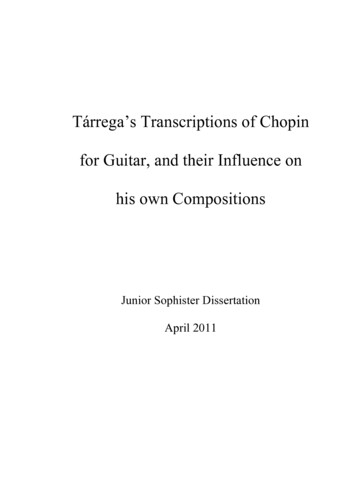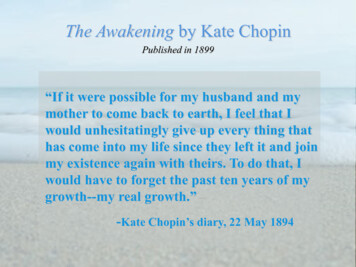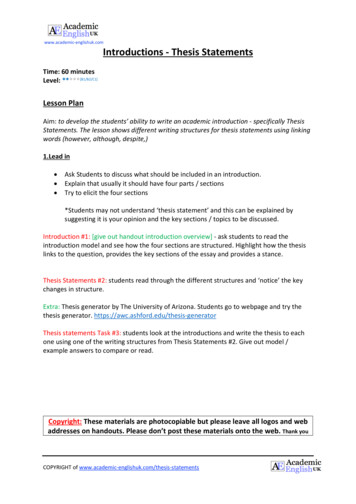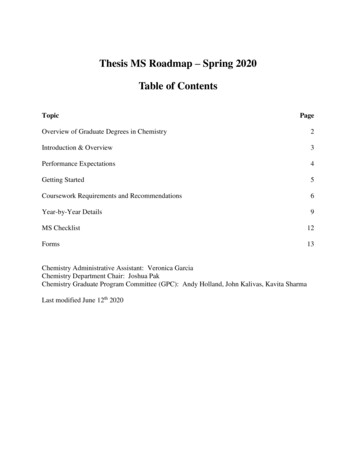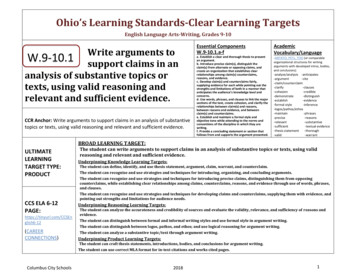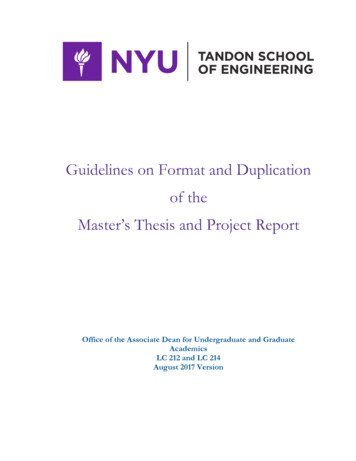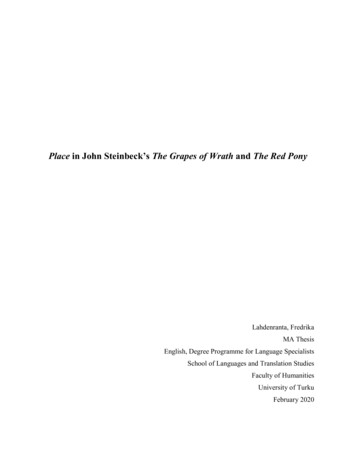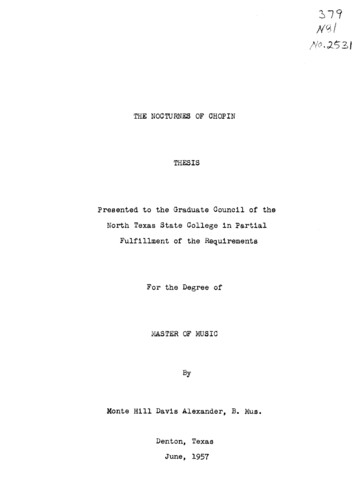
Transcription
Y7vYA2%2THE NOCTURNES OF CHOPINTHESISPresented to the Graduate Council of theNorth Texas State College in PartialFulfillment of the RequirementsFor the Degree ofMASTER OF MUSICByMonte Hill Davis Alexander,Denton,June,Texas1957B. Mus.
PREFACEA nocturne is a night piece,or instrumental serenade,usually of a quiet lyrical nature, but sometimes(as inChopin's Nocturnes) it has a more agitated middle section. 1The Italian term "notturno" ("night piece") was used inthe eighteenth century to mean music for evening entertainment, and therefore indistinguishable from "serenade."Theterm "notturno" appears at least as early as Haydn (17321809).In 1790 he wrote eight notturni scored for two lireorganizzate (or flute and oboe),two violas and a bass.then King of Naples.two clarinets,, two horns,They were composed for Ferdinand IV,Later Haydn replaced the lira with theviola to enable him to use some of them at Salomon's concertsin London.2Mozart used the term "notturno" in the titleofhis Serenade No. 8 (Notturno), K. 286, written in three movements for four orchestras.3of thisnotturnoInstrumentation of each orchestracalls for one horn, in D, two violins,one1 Theliturgical use of the term "nocturne" for certainnight services of the Roman Catholic Church has no connectionwith the present study.2 MarionM. Scott, "Haydn," Grove's Dictionary of Musicand Musicians, 5th ed., -edited by Eric Blom (London,New York,1954), Vol. IV.3 GeorgearGrove and Eric Blom, "Nocturne," Grove's Dictionof Music and Musicians, Vol. VI.iii
viola, and one basso.The three movements: are: Andante,Allegretto grazioso, Menuetto.Einstein says that K. 286occupies a place between.Mozart's wind serenade and his earlyItalianate symphonies." 4John Field (1782-1837), an Irishman, was the first composer to use the French term "nocturne," and was the inventorof the nocturne for piano.It can be seen with a glance atthe scores that the orchestral notturni by the eighteenthcentury composers,such as the ones previously mentioned,were very different than what is generally thought of todayas a nocturne.Field introduced the idea of the nocturnethat has remained much the same since.Frederic Chopin enlarged and improved the genre inventedby Field, but it was Field'as originality that brought thistype of piece to piano literature.Indeed,John Field ishardly remembered today except as the inventor of the nocturnefor the piano and for his influence on Chopin's Nocturnes.For that alone musicians will remain indebted to him.4AlfredEinstein,Nathan Broder (London,Mozart, translated by Arthur Mendel andNew York,: Paris, 1945), p. 208.iv
REFACE.LIST OF ILLUSTRATIONS.".,0"PPageiii"TABLE OF CONTENTSvi,S.IChapter.THE NOCTURNES OF FREDERIC THE NOCTURNES OF JOHN FIELD.I.077
LIST OF ILLUSTRATIONSFigurePage1.Chopin, Nocturne0.2.Chopin, Nocturne .3.Chopin, Nocturne om. 9, No. 1, mm.-15-184.Chopin, Nocturne 2g. 9, No., No.1,. m. 52 . . . . .17. . . . .18.24.275.Chopin, Nocturne Qm. 1.5, No. 1, mm. 23-25 . . . .306.Chopin, Nocturne .7.Chopin, Nocturne8.Chopin, Nocturne 2.9.Chopin, Nocturne9, No. 1, mm. 2-3., mm. 88-891, mm. 17-24.312, mm. 1-3. .32.38No. 2, mm. 62-64 . . . .39Comparison of Field Nocturne No. 5 and ChopinNocturne p. 32, No. 2 . . . . . . . . . .4111.Chopin, Nocturne 2. 37, No. 2, mm. 13-16 . . .4612.Chopin, Nocturne22. 55, No. 2, m. 9.5310.15,No.22. 15,No.2,22. 27,vi.No. 2, mm. 42-45 .- . . .
CHAPTER ITHE NOCTURNES OF JOHN FIELDThere is an extreme scarcity of material written aboutJohn Field.W. H. Grattan Flood's book (see Appendix forthat work in itsstudy in English.entirety) apparently is the only separateIn his book there is an acknowledgment ofa German study on Field by Heinrich Dessauer that was presented as a thesis for the degree of Doctor of Philosophy atthe University of Leipzig (not available for this study).Beyond this there are only brief articles about Field inGrove's Dictionary of Music and MusiciansUniverselle des Musicians,Eric Blom' sEverm an'sDe Bekker's Music and Musicians,DictionaryBiographical Dictionary ofFetis' Bio raphieofmusicians,Music,Theodore Baker'sPercy Scholes'TheOxford Companion to Music, and David Ewen's Composers ofYesterday.Owing to this lack of bibliography on Field, thematerial for the following synopsis of Field's career has,unless otherwise indicated in footnote citations, been basedon Flood's work.When published,Flood's John Field ofDublin was limited to 450 copies, printed from hand-set type.This was in 1920, and it is doubtful that many copies are inexistencein America at the present time.1
2John Field was born in Golden Lane, Dublin, on July 26,1782.For two or three generations the Fields had been em-ployed as professional musicians and John Field began hisstudies of music, specifically of the piano,seven.when he wasHis grandfather taught him, and his father super-vised his practice.In 1791 he wassent to the then famousTommaso Giordani 1 for "finishing lessons" on the piano.Hemade his first major public appearance at the age of nine inDublin.In the year 1793 he blossomed forth as a composerand published an arrangement (with variations) of an oldIrish air: Go to the Devil and Shake Yourself.In the summer of 1793, Field's father was invited tobecome leader of the orchestral concerts at Bath.thus that John Field left Dublin.Robert Field, the father,London which he accepted.It wasLess than six months laterwas offered another engagement inAs soon as the Fields were settledin London, John Field began his studies with Muzio Clementi(1752-1832).He also studied violin with G. F. Pinto,2 who1 "ToimmasoGiordani, " Baker's . Biographical Dictionary of4th ed., edited by Theodore Baker (New York, 1940).Tommaso Giordani was born in Naples,, 1730, and died in Dublin,1806. He was engaged in 1788 as official composer and orchestra director of The New Theatre Royal, Dublin.In 1792 he gavea Lenten series of "Spiritual Concerts," at one of which JohnField, then eight years old, made his second public appearanceas a pianist. Field was nine years old at this time.The advertisements said he was eight years old and apparently Bakeraccepted their word.Musicians,2 CarlFerdinand Pohl, "George Frederick Pinto," Grove'sDictionary of Music and Musicians: (London, New York, 1954),Vol. VI. Pinto was born in London, September, 1786, and diedMarch,1806.He was a violinist,singer, pianist,andcomposer.
later dedicated a piano sonata "to my friend John Field."The sonata was published in 1800.On February 7, 1799, Pintohad a benefit concert at the Haymarket Theatre.attraction was Master Field.composed for the occasion,in The Morning ChronicleThe chiefHe played his own concerto,and was given an excellentreview(February 9, 1799).Clement appreciated the genius of Field but instead ofexploiting him as a virtuoso, he had the idea of a Europeantour, with Field acting as a salesman for the Clementi pianos.In the meantime he published four or five pieces by Field,among which were three sonatas, one dedicated to Clementi.In August,1802, the two pianists went to Paris, where Field'splaying of Bach's Fugues and of pieces by Handel and Clementitook that city by storm.At length they reached St. Peters-burg, where Clementi opened a showroom for the sale of hisfirm' s pianos.He was stillusing Field to display the instru-ments to the best advantage.33 "'Clementi,'a man in his best years, of an extremelylively disposition, and very engaging manners, 'liked verymuch to converse with me (in French, which from my greatpractice in St. Petersburg I soon spoke pretty fluently)'and often invited me after dinner to play at billiards.Inthe evening, I sometimes accompanied him to his large pianoforte warehouse, where Field was often obliged to play forhours to display the instruments to the best advantage to thepurchasers.The diary speaks with great satisfaction of thetechnical perfection and the 'dreamy melancholy'of thatyoung artist'sexecution.I have stillin recollection thefigure of the pale, overgrown youth, whom I have never sinceseen.When Field, who had outgrown his clothes, placed himself at the piano, stretched out his arms over the keyboard,so that the sleeves shrunk up nearly to the elbows, his wholefigure appeared awkward and stiff in the highest degree; but
4When Clementi left St. Petersburg in 1803, Field stayedbehind as a guest of General Merkloffski.During the years-1804 to 1807 Field's services as a virtuoso and as a teacher,were much in demand, and he gave numerous concerts whichproved highly remunerative.He soon acquired a knowledge ofFrench, German, and Russian,and was a great favorite in themost select circles.He became indolent and frivolous dueto so much petting plus the fact that he was very absentminded and eccentric.He married a young French actressearly in 1808 with whom he lived for five years.Field composed the first three nocturnes in the autumnof 1814 that were published, along with a piano sonata andsome concerti, at St. Petersburg in November.During the years 1815 and 1819 Field gave concerts inSt. Petersburg and his reputation as a piano teacher continuedas soon as his touching instrumentation began, everythingelse was forgotten, and one became all ear. Unhappily, Icould not express my emotion and thankfulness to the youngman otherwise than by a silent pressure of the hand, for hespoke no other language but his mother tongue.Even at that time, many anecdotes of the remarkableavarice of the rich Clementi were related, which had greatlyincreased in latter years when I again met him in London.It was generally reported that Field was kept on very shortallowance by his master, and was obliged to pay for the goodfortune of having his instruction with many privations.Imyself experienced a littlesample of Clementi' s true Italianparsimony, for one day I found teacher and pupil with up-turned sleeves, engaged at the washtub, washing their stockingsand other linen.They did not suffer themselves to be disturbed, and Clementi advised me to do the same, as washing inSt. Petersburgh was not only very expensive, but the linensuffered greatly from the method used in washing it." LouisSpohr, Louis Spohr' s Autobiography, anonymous translation fromGerman London, 1865), pp. 39-40.
5to grow.His best known pupil at this period was MichaelIvanovich Glinka,forRussianthe founder ofthe Czar, 1836;Russian and Ludmilla,Russian School of Music.National Opera (Life1842) and of theIn 1817 Field composed his Con-certo No. 5, known as L' incendie parStorm Concerto in London in 1821).The year 1817 was alsomemorable for Nocturnes Nos. 4 and ,Flood regards the Nocturne inA' orage (played as The(in A and in B flat). 5as one of the most beautifulpieces of its kind ever composed.Dr. Ernest Walker in hisHistory of Music in England (1907) pronounces it as not only"a most beautiful thing," but he styles itpiece.""Field's master-In 1820 Field's Zfocturnes had not been heard inEngland or in Ireland.In 1822 the Nocturne No. 6 in Fappeared, and was followed by the Nocturne No. 1 in C in 1823.Of the latter nocturne, Schumann wrote in terms of the highestpraise (Neue Zeitschrift).to Theodore Baker's "Glinka," Biogrphical4th ed., (New York, 1940), Glinka(1804-1857) had only three lessons with Field.'AccordingDictionary of5 AsMusicians,it is impossible to determine the edition used byFlood, it is difficult to ascertain of which nocturnes he isspeaking.The source of this study is the Schirmer editionof John Field Nocturnes for the Piano, which contains apreface from the original Liszt edition.However, this doesnot necessarily indicate that the two editions have the samenumerical sequence.Any numbers mentioned when referring tospecific nocturnes correspond to those found in the Schirmeredition.
6In the same year (1822), Field settled in Moscow andbecame very friendly with Hummel.6During the next six yearsField drifted into such reckless Bohemianism as to neglecthis professional engagements and to ruin his health.On February 27,was much admired,1832, he played in London.especially his performanceConcerto in E flat.His playingof his ownHe also played at the centenary ofHaydn's birth on March 31, and his playing was highlypraised by the critics.Field's visit to London was sad-dened by the death of his friend Clementi, who died onMarch 18, 1832.There too he met Mendelssohn at a receptiongiven by Moscheles on May 6.7Field then went to Paris to play a series of recitals.The critics lauded him which was all the more remarkable because Chopin had given concerts there some months previously.to Baker's Biographical Dictionary of Musicians,(New York, 1940), Hummel was Mozart's pupil for two6 According4th ed.years.In a letter to his teacher C. F. Zelter (1758-1832) dated1830, Mendelssohn remarks "Here, in Munich, the musicians .believe that good music may be considered a heaven-sent gift,but just in abstracte, and as soon as they sit down to playthey produce the stupidest, silliest stuff imaginable, andwhen people do not like it they pretend that it was still toohighbrow. Even the best pianists had no idea that Mozart andHaydn had also composed for the piano; they had just thefaintest notion of Beethoven and consider the music of Kalkbrenner, Field and Hummel classical and scholarly.On theother hand, having played myself several times, I found theaudience so receptive and openminded that I felt doubly vexedby those frivolities."Apparently Mendelssohn did not rankField's compositions very highly. G. Selden-Goth, editor,Felix Mendelssohn Letters (New York, 1945), p. 82.
7Field did not thins highly of Chopin, whom he described as- a"sick room talent"("un talent de chambre de malade").When Field played at the Conservatoire of Paris onDecember 25, 1832, Fetis, one of a fashionable and criticalaudience present, declared his playing astonishing.Anotherenthusiastic critic on this occasion was Joseph d'Ortigue(1802-1866) of the Balcon de 1'pera.He wrote at greatlength about the marvelous qualities of Field's playing.Throughout the spring and summer of 1833 Field astonishedand thrilled such European centers as Brussels, Toulouse,Marseilles,and Lyons, by his virtuosity.He then played inGeneva, Switzerland, and went on to Italy to give equallyoutstanding concerts.The strain of the year's tour provedtoo much for a neurotic man of fifty-two.illin Naples in 1834.He became seriouslyHe had to be operated on for a fistulacondition accelerated by his habits of intemperance.Afterbeing in the hospital nine months the timely arrival inNaples of the Rachmanoffs,a family of Russian nobles,rescuedField from his unfortunate situation.He left Naples and traveled with the Rachmanoffs whogradually made their way back to Moscow.When passing throughVienna, Field was guest of Beethoven's pupil, Karl Czerny(1791-1857).Being in congenial surroundings helped him bothphysically and mentally, and he was persuaded to give threeconcerts at the Hof Theatre on August 8, 11,. and 13, 1835.
8While in Vienna he composed a new concerto and a nocturne.The nocturne is dated August 13.Field returned to Moscow with the Rachmanoffs during thelatter part of August.In November,1836,he became very ill.His friends tried to help him but by Christmas it was evidentthat the end was at hand.He died January 11, 1837, and wasburied four days later at a public funeral in the WedenskyCemetery, Moscow.In regard to the authenticity of the statement thatField invented the nocturne, Flood says there is no doubtthat he did invent this type of piece for the piano, andquotes Michel Brenet as writing: "In regard to the inventionof the Nocturne itis a fact sufficientlywell established.Field was the inventor."From the RepertoireEncyclopediquedu Pianiste--Tom.I,p. 99, Flood quotes H. Parent as saying that "Field's greatdistinction in the musical world is to have created a genre-the little pieces to which he has given the name of Nocturnes." 8Of his pianoforte pieces,his concerti and mainly hisnocturnes will perpetuate his name.Owing to the lack of pre--cision on the part of some publishers, the name "nocturne" hasbeen applied to several pieces not intended as such by Field.8 EdwardDannreuther, in his article "Field," Grovesof Music and Musicians, 5th ed., edited by ericBlom (London, New York, 195),TVol. III, says that we owethe form, the kind of emotion of the nocturne, and the widespread chord accompaniments of Chopin's Nocturnes, and more,to Field.Dictionary
9For this reason publishers' lists contain various numbers ofnocturnes.Field composed sixteen compositions for the pianocalled "nocturne."Flood says No. 2, 2, 4,Liszt' s edition stand out pre-eminently.9ItI, andinis about thesefive that Dannreuther writes "five delicate little lyricsare the very essence of all idylls and eclogues."To thesefive Flood adds a sixth, No. 8 in E (given as No. 10 inPeter's edition).Most English critics regard No. 4 in Aas the best of Field's nocturnes.As to the value of Field's nocturnes Flood cites theverdict of the German musicologist,Hugo Riemann:"Field maybe justly described as one of the most original pianisticphenomena."(For a list of Field's compositions seeAppendix.)Nocturnes of Field--Comparison with Chopin:To the present day musician the name John Field meanslittle more than "the inventor of the nocturnes."His musicis hardly ever programmed for public performance and is indanger of being forgotten by future generations.However,the importance of his influence on Frederic Chopin will alwaysremain significant.same "nocturnes. "This influence is mainly seen in theseChopin enriched this style of music im-mensely but the original idea was Field's.9Seeante footnote 5.
10When Field wrote his nocturnes, not only the name wasnew,1 0 but the whole style and melodic character of thesepieces were original.Field introduced a style in whichfeeling and melody could reign supreme, as they were freedfrom the boundaries of the established styles and forms.He opened the way for all the productions which havesince appeared under the various titles of Song without Words, Impromptus, Ballades, etc., and to him wemay trace the origin of pieces designed to portraysubjective and profound emotion. 1 1In 1859 J. Schuberth and Co. at Leipzig published sixof Field's nocturnes.Franz Liszt wrote a preface to gowith this collection which he had revised, and which may befound in the present day Schirmer edition.Itis very dis-appointing to read Liszt's remarks about Field's nocturnes.He is one of the few sources of Field's time and, being oneof the greatest composers and pianists,one expects somehelp when reading about one of his elder contemporaries.Liszt can find no fault with Field.He is "appreciative"in such a general way, praising Field's simplicity,praising his ornamentation,that itis difficult to cullspecific points of information of criticism.ments that the firstthenHe makes com-and fifth nocturnes in the collectionare marked by a radiant happiness,and says that "in thesecond the tints are darker, like those of daylight in a1 0 SeePreface,p. iv.l1 Theodore Baker, Preface to John Field, EighteenNocturnes for the Piano (New York, 1893).
11shady avenue. 1 2This is pretty writing but little can begained by reading it.Moreover, no great importance can beattached to these flowery statements because it has not beenpossible to establish that Liszt's numbering corresponds tothat of the only edition available for this study.be of some assistance ifItwouldhe had at least named the keys ofthese nocturnes.The most obvious traits in which Field's influence canbe seen in Chopin's nocturnes are their common use of thewidespread left hand accompaniments,the use of fioriture,the type of melody and its embellishments.The general style of Field's nocturnes is much morevaried than that used by Chopin.Chopin's nocturnes are allof a rather "poetic" type, though varied internally by amore agitated or a calmer middle section which usually contrasts thematically with the firstsection. 1 3An exampleof the variety of mood of Field's nocturnes may be seen inNocturne No. 12.Perhaps this is one of the nocturnes not originallyintended to be so named by Field.Furthermore it is doubt-ful that the twentieth century listener would think of1 2 FranzLiszt, Preface to John Field,for the Piano (New York, 1893).EighteenNos.,sonata.It suggests a gay rondo of a classicalNocturnes1 3 The term "section" will be used throughout this work todesignate the firstlarge portion of a composition, the secondportion, which usually begins approximately a third of the waythrough the piece, and if there is one, the third portionwhich is usually at least similar in thematic material to thefirstportion.
1216, and a,firstifheard in their entirety,, as nocturnes.1theme of No. 10suggestsatfirst4Thea simple melodiouscomposition, but as it proceeds it is embellished with somuch finger work as to make itsound more like a show piece.No. Z sounds as suitable for the voice, or even more so,than it is for the piano.firstsixteen measures,an introduction,This is partly achieved in thewhich, in fact, sound very much likeand do not occur again in the piece.has much the same effect but not to the same extent.other hand,No.18On thein the Schirmer edition, No. 15 has "Song withoutWords" written under the title"Nocturne."15This does notseem to be as apt a subtitle as it would have been for eitherof the two previously discussed nocturnes.With the exception of Op. },.No. 2, Chopin' s nocturneshave the common characteristic of the main theme first presented in a single melodic line usually well above a widelyspaced accompaniment.Field's nocturnesThis is true of most,(exceptions are Nos. }3,but not all, of, and1 ).Noc-turnes which have melodic lines- that could be easily14This is undoubtedly due to the fact that the twentiethcentury listener is educated to hearing Chopin' s nocturnes.As has been stated they are music of a more general type.They are romantic night-music" and without exception havethe same sentimental and melancholy mood.1 5 TheSchirmer edition cites no authority for the occasional subtitles found in Nos. 6, 0, l2, j}, and 1 .Thetitle'Noonday" is applied to an unidentified nocturne inBaker's translation of Liszt' s preface.However, in thebody of music which follows the translation, "Noontide" isapplied to Nocturne No. 12 (by Baker?).
13recognized--indeed, such as Chopin.might have written--areNos. 1,,8, 2,and .Perhaps a fact that makes them allthe more alike is the triplet figure used in the accompaniments.Field wrote almost all his nocturnes in triple time(6/8, 12/8, 3/8, 3/4).This of course lends itself well totriplet and sextuplet patterns which are very prominent inthe nocturnes.Chopin, too,employed such rhythmic patternsa great deal in the accompaniments of his nocturnes (see.Figure 2, p. 18).For the most part the melodic interest of Field's nocturnes is much less than that of Chopin's.One reason forthis is that the second section of the piece is often sosimilar to the first that it is difficult to distinguishbetween them (e.g.,Nos. 1, 8, 2, 11, l1, and 14).In suchcases the effect is that of dull repetition, and in thosecases where the first section recurs at the end of the composition the listener is not certain whether it is indeed areprise of the firstmiddle section.section or merely a continuation of theThen, too, Field sometimes uses themes be-yond the limit of effectiveness(e.g., Nos.exhausting the resources of the melody,nothing worthwhile has happened.11 and 12); afterthe feeling is thatMost of the melodies arepretty, simple melodies, but they are not interesting enoughto be used repeatedly for three or four minutes of listeningor playing.Field is at his best in pieces in which he con-fines himself to a simple form on a small scale.One of the
14best examplesof lack of melodic imagination in Field's noc-turnes can be seen in Nocturne No. 11 in,Eflat major.Thepiece is 118 measures long and it is made up almost entirelyof the first theme.The accompaniment keeps a monotonouseighth note triplet figure going almost continually.Theharmonic scheme scarcely varies from the I, IV, V, or V 7chords throughout the piece.One of the important differences and great improvementsChopin made over Field's nocturnes is found in the harmonicelement of their nocturnes.Rarely does Field deviate fromthe simpler harmonic backgrounds, and when there is a morecomplex harmony itis found not in the body of the nocturne,where it might add interest and complexity to the melodicmaterial, but in the short transitions between sections.Inthe Chopin nocturnes one finds considerable harmonic variation incorporated within the melodic sections as well asintricate and complex modulations which also make up much ofthe transitory material.16Other examplesof a rather un-usual harmonic simplicity may be found in Field's NocturnesNos. I inEflat ma jor, 2 in C minor, andin A flat ma jor.16 Acomparison of the first sections of approximatelength, one of Field and one of Chopin, divulges the following information: in the Field Nocturne No. 16 in C majorthe followingdifferent keys are suggested harmonically:C major, A minor, and G major; whereas, in the Chopin Nocturne 22.No. 2, one hears G major, A minor, B flat major,D flat major, E flat minor, F major, F minor, and E minor.3,
15The form of Field's nocturnes is more varied than thatof Chopin's nocturnes.Of those that fitinto an establishedformal type there are seven that can be analyzed as three-partsong form (Nos. 1, 2, 7,L2,10, 11, and 17), four in not verystrict rondo form (Nos. 4, 12, 13, and 16), five in two-partsong form (Nos. ,,(No.2),8, 14, 15, and18),one in variation formand one in sonata allegro form (No. 6).From the above itlater composers.can be seen how Field freed form forBecause of the irregularity of form of themore free nocturnes,they do not emerge as a unified whole.A particularly obvious similarity between the two composers is found in comparing Chopin's Nocturne 9 . 32, No. 2,mm. 27-50, to Field's Nocturne No.(see Figure 10, p. 41).,ma. 18-21 and mm. 38-41Another nocturne by Field that musthave influenced Chopin is No.6in F major which is melodi-cally similar to the famous E flat Nocturne of Chopin,No. 2.It is interesting to note in Nocturne No.22p.2,by Fieldthat the first thirteen notes, combining the two upper voicesin the right hand, suggest the melodic line of Chopin'sEtude .10, No. 11.Field may have been the inventor of the nocturne but itneeded the genius of Frederic Chopin to bring out its greatpossibilities,and to raise itthat it has attained today.to the heightof poetic music
CHAPTER IITHE NOCTURNES OF FREDERIC CHOPINFrederic Chopin was born in Zelazowa Wola, Warsaw,Poland, in 1810, and died in 1849 in Paris, France.He was"one of the creators of the typically romantic idiom and assuch one of the most original and remarkable creative geniusesin musical history." 1Some influences that can be traced in Chopin's writing are:(1) in the Italian opera of Rossini 2(and perhaps Bellini 3 );1Paul Henry Lang, Music in Western Civilization (New York,1941), p. 814.2Thefollowing is part of a letter from Chopin to JanBialoblocki in November of 1825: "As for how things go, thatyou know from my last letter that-the Barber has been praisedeverywhere on the stage; and Freischtz, which has been expected so long, is to be given.I have done a new polonaiseon the Barber, which is fairly well liked; I think of sendingit to be lithographed tomorrow." Henryk Opienski, collector,hopin's Letters, translated by E. L. Voynich (New York, 1931),p.1.Style5 Accordingto Gerald Abraham, Choin'sMusical(London, New York, Toronto, 1939), p. 61: That Chopin's melody isheavily indebted to Bellini's is a commonplace of criticism."It is impossible to determine whether Chopin had heard any ofBellini's music before his more "Italianate"a.traitswere de-veloped, but of the nocturnes, the pieces in which this traitis perhaps most apparent, the2 Nocturnes were written in1832, one year after Chopin went to Paris.It seems very possible that he had heard some of Bellini's compositionstime.16by this
17(2)in the musical form of Field, 4of Poland.(3) in the national music5The influence of the Italian opera is prevalent in thesong-likemelodiesof the nocturnes and nowhere isinfluence more apparent.John Field'sThe Polish influence is seen mostreadily in such compositions as the mazurkas and polonaises.In the nocturnes there islessevidence of this influence,butat least one such example can be seen in the mazurka-likerhythmic pattern that follows:Fig.1--Chopin,NocturneM.55, No.1, m.52In Chopin's nocturnes is find the composers most intimatewriting.They depict moods best described by such terms as"atmospheric,""dreamy,""poetic,"The melody in the nocturnesand "sentimental."is the primary factor.the exception of one nocturne (Op.37, No.With2) they invariablyhave a single melodic line as the first thematic material.This is generally elaborated with great finesse by such devices as the fioriture,4 Seeante p.mordent,turn,the presentation of the15.5Arthur Medley, "Chopin," Grove's Dictionary of i4usic andMusicians, 5th ed., edited by Eric Blom (London, New York,1954),Vol. II.
18melody in octaves,.and suspensions.chromaticism,, and the use of passing notesChopin has innumerable ways of keeping themelody interesting.Some evidences of vocal influence can be seen in the useof coloratura,as is seen in the following example:Fig. 2-'-Chopin, Nocturne, 22p. 9, No.1, mm. 2-3Other examples of this influence can be seen in Nocturne22. S., No. .,. mm. 10411, and Nocturne Qp. l, N o 2, m. 18.Another vocal characteristic can be seen in the recitativelike element used in the coda of Nocturneo.3 2,Nmo.,m. 63 (also see second section of Nocturne
Dictionary of Music and Musicians: (London, New York, 1954), Vol. VI. Pinto was born in London, September, 1786, and died March, 1806. He was a violinist, singer, pianist, and


